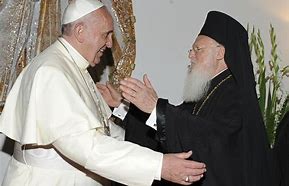 |
 |
 |
The formation of a Catholic community of the Byzantine rite in the Ottoman Empire became possible only after 1829 when Ottoman Sultan Mohammed II removed previous restrictions.
A Latin priest, Fr. John Marangos, began missionary work among the Greek Orthodox in Constantinople in 1856 and eventually formed a very small group of Byzantine Catholics. In 1878 he moved to Athens (where he died in 1885), and his work in Constantinople was continued by Fr. Polycarp Anastasiadis, a former student at the Orthodox Theological School at Halki. In the 1880s Byzantine Catholic communities were also formed in two villages in Thrace.
In 1895 the French Assumptionist Fathers began work in Constantinople where they founded a seminary and two small Byzantine Catholic parishes. These Assumptionists were distinguished above all for the valuable scholarly studies they produced on the eastern churches.
On June 11, 1911, Pope Pius X created an Ordinariate for the Greeks in the Ottoman Empire and on June 28 of that year named Fr. Isaias Papadopoulos as its first bishop. He was succeeded in 1920 by Bishop George Calavassy (1881-1957). It was his task to oversee the immigration of virtually the entire Byzantine Catholic community of Constantinople to Athens, and those of the two villages in Thrace to a town in Macedonia. This was part of a general exchange of populations that took place between Greece and Turkey in the early 1920s. In 1922 Bishop Calavassy moved his offices to Athens, and in 1923 the Ordinariate was raised to the rank of Apostolic Exarchate. In 1932 the Exarchate was divided into two: Bishop Calavassy remained in Athens, while another exarch was appointed to Istanbul.
Although their presence in Greece aroused the anger of the local Orthodox hierarchy, these Greek Catholics were determined to serve their fellow countrymen by works of charity and social assistance. In 1944, for xample, Bishop Calavassy founded a hospital in Athens under the direction of the Pammakaristos Sisters of the Mother of God. By the time it was taken over by the Greek state in 1994, it was well known as one of the best in the nation. The sisters also direct a home for children with special needs, a home for the elderly, a female students's residence, and a house of prayer in the Kifisia area near Athens. The Exarchate publishes Katholiki newspaper every two weeks and a newsletter in French, and runs a Catholic bookstore in the center of Athens.
The Greek Orthodox Church remains very hostile to the very idea of the existence of this church, which it views as a gratuitous creation of the Catholic Church in Orthodox territory. In 1975 Anarghyros Printesis (born 1937) was appointed Apostolic Exarch for the Byzantine Catholics in Greece over the strong objections of the Orthodox Archbishop of Athens. He would serve in that capacity for 33 years until Pope Benedict XVI accepted his resignation in April 2008. His successor, Dimitrios Salachas, taught canon law in Rome for many years, served as a consultor of the Oriental Congregation, and is a member of the international Orthodox-Catholic theological dialogue.
The community remains very small. In Greece, most of the faithful live in Athens, while in Turkey one small parish exists in Istanbul, currently without a priest. In recent years, however, thousands of Chaldean, Ukrainian and Romanian Eastern Catholics have arrived in Greece, swelling the ranks of the faithful to much larger numbers. In Greece there are three parishes served by ten priests, all of them celibate and originally of the Latin rite.
Location: Greece and Turkey
Head: Bishop Dimitrios Salachas (born 1939, appointed 2008)
Title: Apostolic Exarch for Catholics of the Byzantine Rite in Greece
Residence: Athens, Greece
Membership: 2,325
Website: www.elcathex.com
Last Modified: 26 Jun 2008